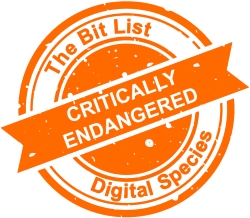Community-generated Content in Arts and Heritage
 |
||
|
Digital materials produced and shared in and by ad-hoc community art and heritage projects, typically through digitization, where the creation of digital materials was a significant purpose of the initiative. |
||
|
Digital Species: Community Archives |
Trend in 2023:
|
Consensus Decision |
|
Added to List: 2019 |
Trend in 2024:
|
Previously: Critically Endangered |
|
Imminence of Action Action is recommended within twelve months. Detailed assessment is a priority. |
Significance of Loss The loss of tools, data or services within this group would impact on people and sectors around the world. |
Effort to Preserve | Inevitability Loss seems likely. By the time tools or techniques have been developed, the material will likely have been lost. |
|
Examples Locally organized programmes associated with public remembrance and celebration such as World War One centennial commemorations; Holocaust commemorations; City of Culture; Olympic Games; World Cup. |
||
|
‘Practically Extinct’ in the Presence of Aggravating Conditions Poor documentation; lack of replication; lack of continuity funding; lack of residual mechanism. dependence on a small number of volunteers, lack of preservation mandate; lack of preservation thinking at the outset; failure of digital legacy planning; conflation of backup with preservation; conflation of access and preservation; inaccessible to web archiving; lack of knowledge or application of standards to ensure good quality preservation actions; lack of internet access; distrust of ‘official’ archives; uncertainty over IPR or the presence of orphaned works. |
||
|
‘Endangered’ in the Presence of Good Practice Residual archive with residual funding able to receive and support collections; strict adherence to digitization guidelines; quality assurance; active user community; intellectual property managed to enable preservation. |
||
|
2023 Review This entry was added in 2019 as a subset of ‘Community Archives and Community-Generated Content’ which was split into two entries to provide greater specificity in recommendations. The 2020 Jury noted a trend towards greater risk based on how community art and heritage groups, which often rely on volunteer effort, had been unable to meet for extended periods in 2020. Moreover, the local galleries, museums and arts centres on which they depend had closed, in some cases for good. The 2021 Jury review agreed with this assessment with the overall risks remaining on the same basis as before (‘No change’ to 2021 trend). The 2021 Jury commented that risks have not increased as so much as the challenges have remained, specifically those of funding and sustainability. Community-generated materials are often produced and shared through funded projects and tell a similar story of loss through inaction, but the challenge is the same as before; sustainability with project-based funding. There should be greater responsibility of funding bodies to ensure that digital preservation is built into any funded community preservation project plan and outcome. Digital content in this context is often seen as a by-product of engagement and is annoyingly left to disappear by organizations that do not have digital preservation experience or infrastructure. With good governance and sustainable digital repository support, this should not be an issue. The 2023 Council agreed with the Critically Endangered classification, with the overall risks remaining on the same basis as before (‘No change’ to the 2023 trend). However, they noted there was a higher significance of loss as well as a higher inevitability of loss, and from these also a greater imminence of action needed to assess, prioritize, and develop tools and techniques for reducing future loss of materials. |
||
|
2024 Interim Review These risks remain on the same basis as before, with no significant trend towards even greater or reduced risk (‘No change’ to trend). |
||
|
Additional Comments Local archives address these collections on an ad hoc basis. Loss seems likely due to the precarity of the funding streams, or lack thereof, for these projects. Once digitization has been carried out, many projects do not know what to do with them or have the means to make them accessible, and a lack of understanding of copyright is a barrier to sharing as well. Funding paths that enable digitization may not include planning for long-term storage and access. This often tends to be the case in local archives, where a higher imminence of action is critical to assess and address these issues before content is lost. Communities who live in rural and remote areas may have a lack of access to services such as broadband connectivity, which is a well-reported issue and is often referred to as the “digital divide”. Inadequate internet connectivity would diminish the capacity for these communities to access digital preservation solutions, such as cloud storage for digital assets. This is especially prevalent with personal photos and videos on mobile phones as possession of a mobile phone does not necessarily mean the user has adequate internet connectivity to be able to upload videos to web-based platforms. There may also be a distrust of ‘official’ archives and government agencies due to the need for culturally appropriate handling of restricted/sensitive content. If the photographs, videos or audio depict culturally sensitive elements (e.g., sacred sites, ceremonies or secret Dreaming stories), the communities may want to uphold strict practices of restrictions (see also the ‘First Nations Secret/Sacred Cultural Material’ entry). There are instances where ‘official’ archives have changed their workflows and processes to accommodate the cultural wishes of particular First Nation communities, especially for secret/sacred content but these practices are not yet common-place. A detailed look into the preservation issues of secret/sacred content can be found in the New First Nations Secret/Sacred Cultural Material entry. Case Studies or Examples:
See also:
|
||





































































































































